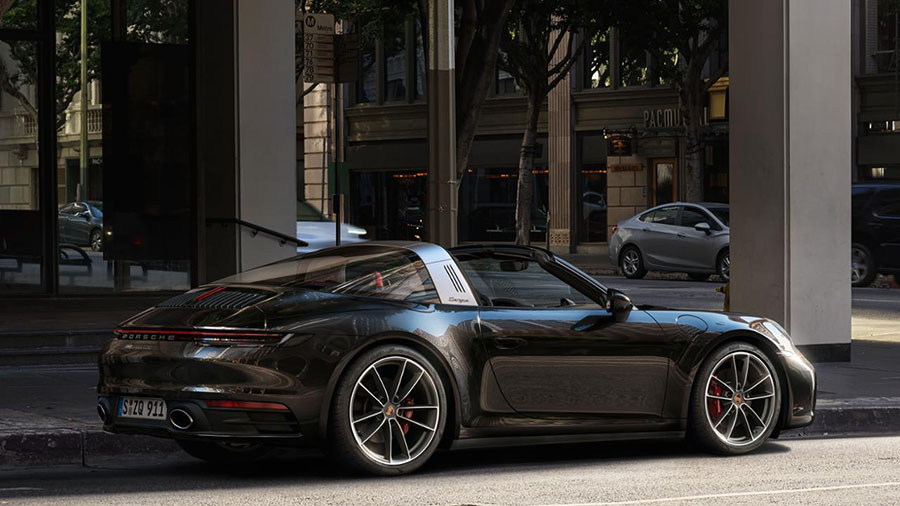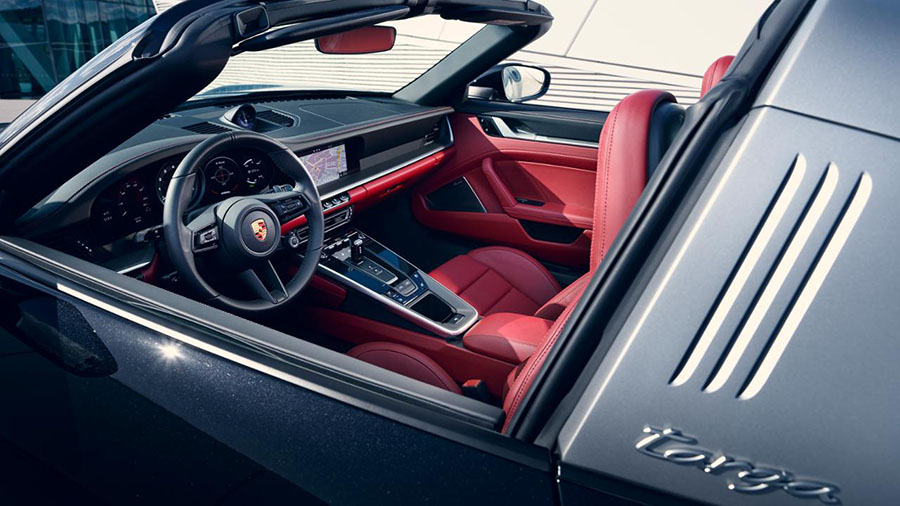Porsche is completing its classic sports car trio this summer: with the all-wheel drive derivatives 911 Targa 4 and 911 Targa 4S, the third body variant of the new 911 generation is making its debut after the Coupé and Cabriolet. The models celebrate their premiere as part of the web TV format 9:11 magazine.

The innovative, fully automatic roof system remains a striking feature. As with the legendary original Targa from 1965, it consists of the characteristic wide bar, a movable roof section above the front seats and the all-round rear window. It can be opened or closed comfortably in 19 seconds.
The six-cylinder boxer engine with three-liter displacement and biturbo charging ensures a powerful appearance: the 911 Targa 4 now delivers 283 kW (385 hp; 911 Targa 4: fuel consumption combined 9.8 l / 100 km; CO 2 emissions combined 223 g / km) and sprints from standstill to 100 km / h in 4.2 seconds with the optional Sport Chrono Package – a tenth faster than before. The engine in the 911 Targa 4S has a nominal output of 331 kW (450 hp; 911 Targa 4S: combined fuel consumption 10.3 – 9.9 l / 100 km; CO 2Emissions combined 235 – 227 g / km) and reaches the 100 km / h mark under the same conditions in 3.6 seconds – four tenths faster than the predecessor. The top speed of the 911 Targa 4 is 289 km / h (plus two km / h), that of the 4S at 304 km / h (plus three km / h).
The eight-speed dual clutch transmission (PDK) and the intelligent all-wheel drive Porsche Traction Management (PTM) ensure the emotional and sporty driving pleasure in both sports cars as standard. The 911 Targa 4S can alternatively be ordered with the newly developed seven-speed manual transmission including the Sport Chrono Package. New technologies expand the range of offerings for both 911 models: Porsche InnoDrive including adaptive cruise control is available for the first time. With the further developed Smartlift function, the increase in ground clearance for everyday needs can be programmed. The options are supplemented by extensive equipment from Porsche Tequipment and new customization options from the Porsche Exclusive Manufaktur.

Efficient boxer engine with biturbo charging
Like the 911 Carrera models, the two 911 Targa variants benefit from the performance increase of the supercharged three-liter six-cylinder boxer engines. This benefits both performance and everyday usability. The engine in the 911 Targa 4 develops 283 kW (385 hp) at 6,500 rpm. That is eleven kW (15 hp) more than the predecessor. The maximum torque of 450 Newton meters is available over a wide speed range from 1,950 to 5,000 rpm. The 911 Targa 4S with 331 kW (450 hp) has 22 kW (30 hp) more power than the previous model, the maximum torque of 530 Newton meters (plus 30 Nm) is between 2,300 and 5,000 rpm.

Optimized all-wheel drive for better traction
The improved performance of the new all-wheel drive models goes hand in hand with a further development of the front axle transmission. The water-cooled clutch and differential unit has reinforced clutch plates for greater resilience and robustness. Increasing the torque on the clutch improves its positioning accuracy and thus the function of the additional drive via the front axle. In total, the further developed front axle transmission with PTM (Porsche Traction Management) supports even better traction in all road conditions.

Further developed chassis for more comfort and safety
The electronically controlled variable damper system PASM (Porsche Active Suspension Management) is standard on the new 911 Targa models. It automatically adjusts the damper properties in terms of driving comfort and handling to the respective driving situation and has two manually adjustable maps “Normal” and “Sport”. The Porsche Torque Vectoring Plus (PTV Plus) including an electronically controlled rear axle lock with fully variable torque distribution is also part of the standard scope of the Targa 4S and is also optionally available for the Targa 4. Like the other eighth generation Porsche 911s, the Targa models also come with Porsche Wet Mode as standard. Sensors in the front wheel arches detect significant moisture on the road. In this case, the driver is advised of a signal in the cockpit, manually switch to wet mode. This adjusts the drive response to ensure maximum driving stability.

The driving dynamics of the 911 Targa 4 include tires on the front axle with dimensions of 235/40 ZR on 19-inch alloy wheels, and 20-inch wheels with 295/35 ZR tires are mounted on the rear axle. The 4S model is fitted as standard with 245/35 ZR tires on 20-inch wheels at the front and 305/30 ZR on 21-inch wheels at the rear. The Targa 4 decelerates 330 mm brake discs with black four-piston monobloc fixed calipers on both axles. The Targa 4S decelerates on the front axle with six-piston calipers and on the rear axle with four-piston calipers, each in red. The brake discs measure 350 millimeters each at the front and rear. The Porsche Ceramic Composite Brake (PCCB) can be ordered as an option.
Extravagant Targa design with a modern interpretation
Externally, the 911 Targa is characterized by the design elements of the 992 model generation. At the front, the body features significantly more concise wheel arches compared to the previous model. Between the LED headlights, the front hood with the embossed recess accommodates the design of the first 911 generations. At the rear, the wider, variably extendable rear spoiler and the seamless, integrated light strip dominate. With the exception of the front and rear parts, the entire outer skin is made of aluminum.

The interior corresponds to the 911 Carrera models and is characterized by the clear and straight lines of the dashboard with the recessed instrument level. The 911 from the 1970s was the inspiration here. In addition to the typical, centrally positioned rev counter, two thin, frameless free-form displays expand the information displays for the driver. Under the 10.9-inch center screen of Porsche Communication Management (PCM) there is a compact switch unit with five buttons for direct access to important vehicle functions. The PCM includes swarm data-based online navigation and Connect Plus including Apple Car Play® as standard.

A model for a new sports car class since 1965
The 911 Targa 2.0 from 1965 paved the way for a new vehicle concept. Initially, the Targa was still marketed as a “safety convertible with roll bar”. But the vehicle with the removable roof soon established itself as an independent concept and developed into a style icon. Porsche still connects two worlds with the 911 Targa: The advantages of “open driving” in a convertible are combined with the everyday comfort and safety of a coupé.









